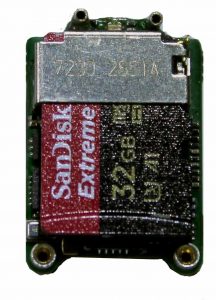MouseLog16C is Deuteron’s latest and smallest neural logger. It is intended for birds, mice, bats and other animals that cannot carry more than 3 grams. It is hardly bigger than the MicroSD memory card that it holds, yet has more features than any previous neural logger.


Features
Neural recording
- 16 channels each sampled at 31250 Hz
- 10mV p-p signal range
- Low noise 2.2µV rms with 7kHz bandwidth
- 7 options for reference signal
Audio recording
- 80kHz on-board microphone
- 50, 100 or 200KHz sampling rates
- 16-bit ADC
Motion sensor
- 3-Axis accelerometer
- 3-Axis gyroscope
- 3-Axis magnetometer (compass)
- 4 Measurement ranges per sensor
- Fast update rate
Optional wired streaming of all data to PC
- Electrically isolated data link to USB
- Continuously stream all data to PC
Multiple battery options
- Plug-in or wired battery
- Select battery size according to required recording time
Small size and weight
- 1.58 grams including memory card
- 1.3g plug-in battery for 100 minutes of recording
- Total weight: 2.88g
- Single horizontal board 18 x 13mm
Battery Options
MouseLog16C is intended for the smallest animals on which wireless Electrophysiology experiments can be performed. Although it is usually best to keep both the logger and the battery on the animal’s head, for the very smallest animals, the battery might be too heavy for the animal to carry on its head. In such cases, it is possible to connect the battery to the logger via a flexible wire and mount the battery on the animal’s back. In all other cases, the use of a plug-in battery is recommended.
Plug-in battery assemblies


The plug-in battery assembly comprises a light circuit board and a small lithium-polymer battery. This is plugged in above the memory card. One must unplug the battery in order to remove the memory card. The actual battery used in the clip-on assembly can be selected so that its weight is the best compromise between being lightweight and having a long recording duration. Using a plug-in battery eliminates the weight of wires and connectors that would otherwise be needed. It also ensures that the battery does not press down on the memory card. One must unplug the battery module in order to remove the memory card from the logger.
Further details
Design details: Mass breakdown